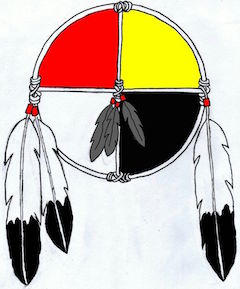Today’s topic is one that came up during a winter golf discussion maybe two or three years ago. Since it was a foreign topic to some of the “golfers,” I decided to talk about it. As I said, that was a number of years ago, but I guess late is better than never….
The name Medicine Wheel may seem like a strange name today, especially considering what comes to mind when we think about medicine. But to the Native Americans, medicine means spiritual and mysterious. These “wheels” are an intricate part of their spirituality and connection to the Earth and sky.
Medicine Wheels have been used for centuries. Hundreds of stone medicine wheels can be found throughout the U.S. and Canada. The oldest known one (in Alberta, Canada) is estimated to be over 5,000 years old. One of the largest and best-preserved is the Bighorn Medicine Wheel in Wyoming.
The Medicine Wheel (also called the Sun Dance Circle or Sacred Hoop) is an ancient and sacred symbol used by many tribes. It signifies Earth’s boundary and all the knowledge of the universe.

To the untrained eye, the Medicine Wheel might seem like a simple circle. But for many tribes, including the Great Sioux Nation, the Medicine Wheel holds a much deeper meaning. It’s shape is a circle, but the accompanying lines, the feather and the wheel’s four directions combine to mean so much more. It is a sacred symbol used to represent all knowledge of the universe. The Medicine Wheel is a symbol of hope — and a movement toward healing for those that seek it.
The circle of the Medicine Wheel represents the sacred outer boundary of the Earth (as I mentioned, often called the Sun Dance Circle or the Sacred Hoop.) Its circular shape represents the continuous pattern of life and death, the path of the sun and moon, the shape of the family home (the teepee,) the shape of the drum and other significant pieces of the Sioux, and other Indian, cultures. The circle plays a role in many Native American beliefs and traditions.
Both the horizontal and vertical lines represent the sun’s and man’s sacred paths. The crossing of the two lines in the middle of the circle indicates the center of the Earth.
It’s not always included in a Medicine Wheel, but when it is, the eagle feather is a sign of the Great Spirit’s power over all. Typically, when someone is presented with a Medicine Wheel with an attached eagle feather, it is to signify a great accomplishment, such as a graduation ceremony or some other momentous life event.
Different tribes interpret the Medicine Wheel differently in terms of direction and color association. Each of the Four Directions (west, north, east and south) are typically represented by a distinctive color, usually black, red, yellow, and white. The Four Directions can also represent the four seasons of spring, summer, fall and winter or the four elements of water, air, earth and fire or the four life stages of birth, childhood, adulthood and elder — and so on.
There is a lot of variation in the construction of the wheels — there is no set number of spokes — some wheels have one spoke that is longer than the rest — with, apparently, some astronomical significance in the direction it points. In some wheels the spokes start from the center and go just to the outer ring, but with some they go out past the outer ring. Some wheels have spokes that start at the outer ring and radiate out from there.
In 1977 an astronomer named John Eddy proposed that some of the wheels had astronomical alignments and suggested that some wheels had spokes pointing to certain stars at certain times of the year, and otherwise marked specific days of the year like the solstices.
But no matter…. Medicine Wheels are another Native American tradition, like Dream Catchers and Talking Sticks that are interesting, but more importantly, worth preserving
— 30 —.
